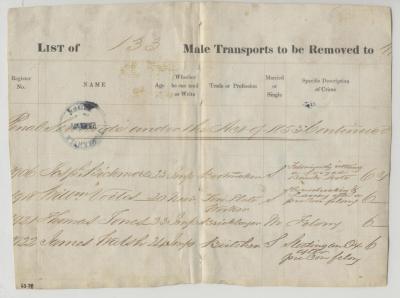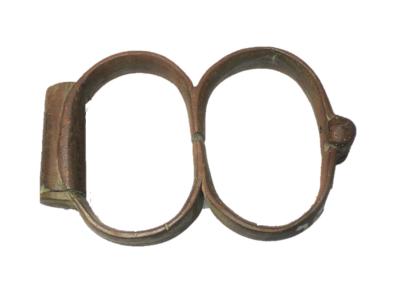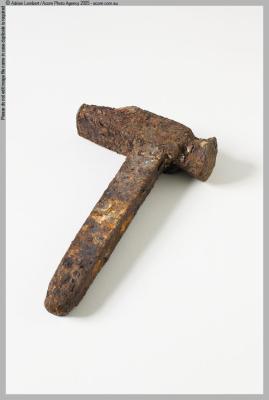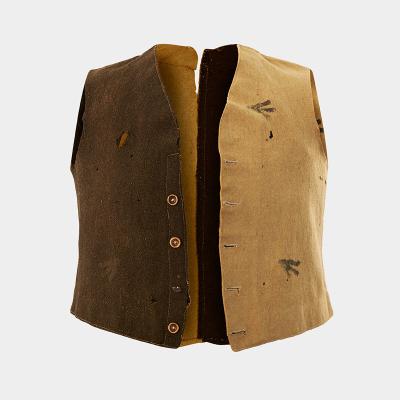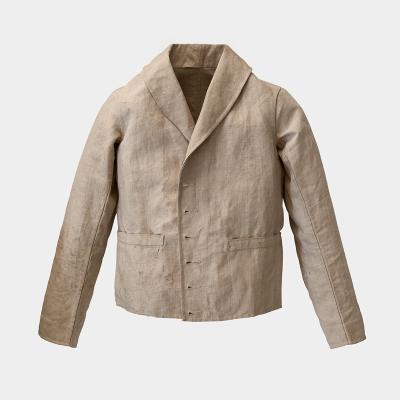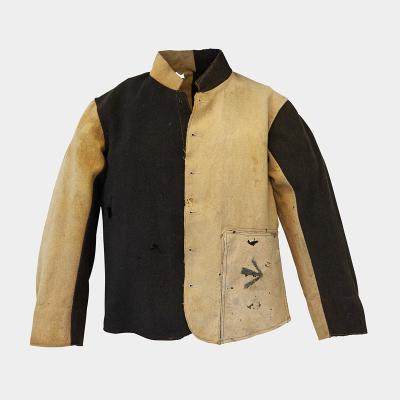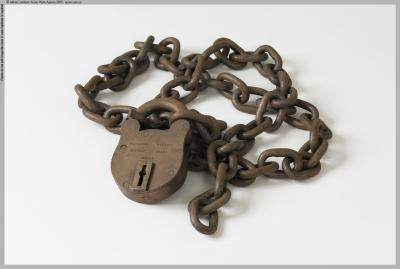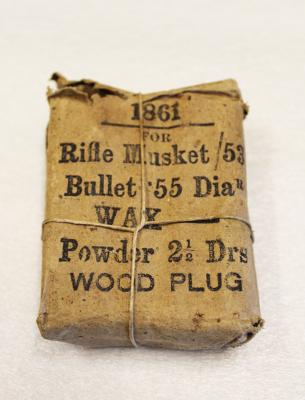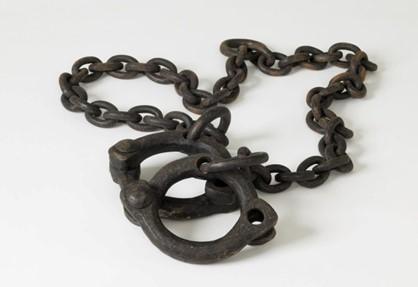SET OF SHACKLES
1850 - 1898Long, thick, iron, shackles. Two thick, round, iron ankle bracelets attached to either end of an iron chain. Each ankle bracelet is made of two semi circular sections of iron attached together at one side with a large iron pin, with provision for a pivot or lock at the opposite side, which is missing. Each bracelet measures H50 x W170 x D125mm. Each bracelet is connected to a long section of iron chain by a large thick, round metal ring, measuring 73mm in diameter. The chain is made up of 25 small, oval shaped, interlocking links. In the centre of the chain is a large, thick, iron ring, measuring 65mm in diameter.
Used at Fremantle Prison.
Details
Details
Shackles, also referred to as irons, or leg irons, were used as a tool of punishment during the convict period in Western Australia. They were made entirely of metal and varied in weight and size. Consisting of a length of chain, they had ‘bracelets’ for the ankles or wrists attached at either end, which were made from two semicircular hoops of metal pivoted together at one side by a metal pin. Provision was made at the opposite side for a similar pin to be inserted and hammered closed, to lock the bracelet around the prisoner’s ankle or wrist. To prevent chafing, convicts often wore a strip of leather or padding sewn together from corduroy, leather and canvas, between the skin and the iron.
The shackles used at the Convict Establishment were imported from England. Records show shackles listed as ‘bazzles’ or ‘basils’, on manifests, and were imported amongst other, “articles for the security of convicts”, onboard ships such as the Clara in 1857, the Nile in 1858 and the Lord Raglan in 1858.
Either as part of an original sentence, or owing to misbehaviour whilst imprisoned, convicts could be sentenced to hard labour in irons. One such punishment was known as a ‘chain gang’, a group of men shackled together and sent out in a work party. The chain gang, or convict parties, that worked in irons, was a common form of organising convict labour on public works. Chain gangs worked up to ten hours a day and often slept in basic huts at night. The men carried out the most labour-intensive elements of road building operations, including cutting down trees, removing stumps, moving large pieces of stone and splitting rock.
During the 1870s a water supply system was established at the Convict Establishment to deliver fresh underground water to ships in the town’s port. Prisoners manned the water pumps inside the Establishment grounds, and if they were also undergoing an additional punishment, they could be required to undertake this work whilst wearing shackles. A medical journal of the time refers to a convict working at the pump whilst in irons complaining of, “Pain in the loins and through the groins.” Examination revealed that, “the skin over both hipbones and in the groins black and blue…in consequence of the weight of the irons bearing on the strap around his loins…” After this examination, the unnamed convict was excused further pumping duties.
The last report of punishment irons being used at Fremantle Prison comes from The West Australian in 1889, which reported that two prisoners wearing 6.3 and 12.7 kilogram irons were manning the water pumps in the grounds. However, it wasn’t until after the release of the 1898 Royal Commission that their use were ceased entirely, after the report recommended the abolition of irons, flogging, the use of dark cells and the crank, as forms of punishment.
As perhaps one of the most highly recognisable artifacts of the convict period, these shackles have international significance due to their strong provenance to the convict era at Fremantle Prison. They have very high social significance, not only as examples of the social system of punishment implemented during this period, but also in today’s society as an object seen as indicative of the convict era.
Open in Google Maps
Nearest geotagged records:
- PHOTOGRAPH OF CATHOLIC CHAPEL AFTER 1988 RIOT (0km away)
- AD REM PRISON NEWSLETTER (0km away)
- CONCERT PROGRAMME (0km away)
- IMAGE OF CHRISTMAS FESTIVITIES (0km away)
- ENTRANCE TO FREMANTLE PRISON (0km away)
- IMAGE OF SALLY PORT (0km away)
- IMAGE OF THE MAIN CELL BLOCK (0km away)
- GATEHOUSE/RECEPTION (0km away)
- IMAGE OF BAKING BREAD (0km away)
- PHOTOGRAPH OF PRISON LIBRARY (0km away)
Nearby places: View all geotagged records »
Other items from Fremantle Prison
- REMNANT OF PAGE FROM SHIP'S REGISTER
- CONVICT DEPARTMENT WESTERN AUSTRALIA SCALE OF RATIONS
- PAIR OF UNARTICULATED HANDCUFFS
- Hammer
- WAISTCOAT FOR CONVICT
- JACKET FOR CONVICT
- JACKET FOR CONVICT
- Chain with padlock
- MODEL OF SAILING SHIP BY SHINER RYAN
- PACKET OF CARTRIDGES FOR RIFLE
- NOOSE
- ANKLE STRAP USED IN HANGING
